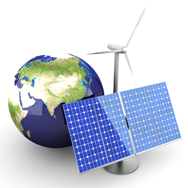Clean Energy Could Supply U.S. with 70% of Electricity by 2030, NOAA Director Says
 A director of the U.S. National Oceanic and Atmospheric Administration (NOAA) was in Vancouver on Friday for the American Association for the Advancement of Science’s annual convention and mentioned in a talk there that clean, renewable energy (not even including hydroelectric) could cheaply supply 48 states of the continental U.S. with 70% of its electricity demand by 2030. The other 30% would be half from fossil fuels and half from nuclear and hydro.
A director of the U.S. National Oceanic and Atmospheric Administration (NOAA) was in Vancouver on Friday for the American Association for the Advancement of Science’s annual convention and mentioned in a talk there that clean, renewable energy (not even including hydroelectric) could cheaply supply 48 states of the continental U.S. with 70% of its electricity demand by 2030. The other 30% would be half from fossil fuels and half from nuclear and hydro.Wow. I mean, we know it’s possible. A piece by Mark Z. Jacobson (professor of civil and environmental engineering at Stanford University and director of the Atmosphere/Energy Program there) and Mark A. Delucchi (a research scientist at the Institute of Transportation Studies at the University of California, Davis) has shown how the world could actually be 100% powered by clean, renewable energy by 2030. But getting more top researchers to show its possibilities in the near future, at a cheap price, is big.
The lead researcher and speaker was Sandy MacDonald, who is director of the earth system research lab at NOAA.
NOAA’s Research
“NOAA embarked on the renewables project three years ago, collating 16 billion pieces of weather data derived from satellite observations and airplane observations and weather station reports,” Scott Simpson of the Vancouver Sun writes.
“Then it designed a program to filter the information to remove unlikely venues for wind or solar power arrays – such as national parks and urban areas – and came up with a map showing robust wind resources in the middle of the continent and decent ones in the northeast Atlantic states, as well as strong solar production areas in the desert southwest.”
But here’s where the NOAA researchers stepped beyond the good to the great, research-wise: they balanced potential power production and electricity demand to determine, how, where, when, and to what extent clean energy could produce the electricity we need. The end result — 70% of electricity demand — is huge (although, not much of a surprise to CleanTechnica readers, I imagine).
You can return to the main Market News page, or press the Back button on your browser.

